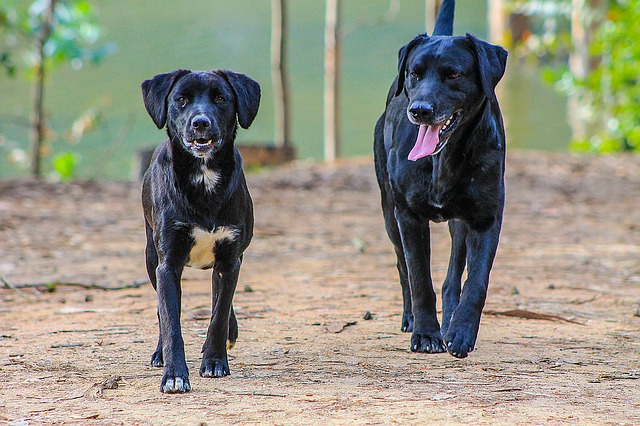In humans, the difference between the sexes is well-determined – “Men are from Mars and Women are from Venus,” it is straightforward.
But what about dogs? When we look at male vs. female dogs, are things that simple in the canine world? Are the differences between male and female dogs so drastic we can allow ourselves to assume they come from different planets?
In this article, we will give an insight on the most significant sex differences between the two sexes.
How Are Male And Female Dogs Different?
In the canine world, the two sexes differ in both looks and temperament. As with most mammals, males are bigger and more muscular than females. They are typically more active, demand more playtime, and leave more urine marks where they walk than females.
Males are naturally more aggressive with other dogs, likely to be more destructive, and have a greater inclination to wander. Untrained, they have a slightly greater risk of snapping at strangers.
Female dogs demand and give more affection and are more companionable than males. They are more willing to learn obedience and usually faster and are easier to house train.
Most of the male vs. female dogs differences described in this article are generalized personality tendencies. In practice, a dog’s character is more directly influenced by factors other than sex – mostly by personality, background, training, and socialization.
In a nutshell, here are the seven most striking sex differences between male and female dogs.
Male VS Female Dogs – 7 Main Differences
1. Male dogs are larger

Sexual size dimorphism is the most striking difference between male and female dogs. The term sexual dimorphism refers to physical differences between the sexes beyond the sexual organs’ appearance. Sexual size dimorphism indicates the size difference between males and females. When saying size, we mean both height and weight.
As a general rule of the thumb, male dogs are higher, heavier, and more muscular than female dogs. However, the exact size difference varies between breeds and is usually more pronounced in larger dog breeds.
For example, let us compare two male vs female dogs: a male and a female Yorkshire Terriers and a male and a Great female Danes. According to breed standards, male Yorkshire Terriers are 8 inches tall and weigh about 7 pounds. Females are about 7 inches tall and weigh the same as males – about 7 pounds. So the size difference between the sexes is an inch in height while there is no difference in weight.
On the flip side, male Great Danes are 30-32 inches tall (76-81 centimeters) and weigh about 140-175 pounds (63-80 kg). Females are about 28-30 inches (71-76 centimeters) tall and weigh about 110-140 pounds (50-63 kg). Therefore, the size difference between the sexes is between 2 and 4 inches in height and up to 65 pounds in weight.
Named after Bernard Rensch, who first described it in 1950, this phenomenon is called the “Rensch’s rule”. Following this rule, if the male breed is larger, the female is significantly smaller. However, once again, the phenomenon is more evident in larger dog breed individuals.
2. Males have bigger heads, shorter backs and nicer coats
Sexual dimorphism of male vs female dogs includes three other essential differences. Namely, male dogs have broader heads, slightly shorter backs, and more superior, more luxurious coats.
The head in males is usually blockier and broader, and in females, it is more delicate and narrow with more elegant and refined facial lines and features.
For example, it is relatively easy for German Shepherds to guess a dog’s sex-based solely on the head’s appearance (See the photos below).
The same applies to Rottweilers, Bernese Mountain Dogs, Shiba Inu Dogs, Belgian Malinois, and Belgian Tervurens.


According to breed standards, female dogs from specific breeds have narrower, longer backs. It is believed that the length of the spine is associated with fertility – the longer the backline, the more puppies can fit inside the dog’s belly.
This concept is particularly true for Norrbottenspets – male members of this breed are rectangular while females are definitely longer than tall. Samoyeds are similar too. Male Samoyeds are slightly longer than tall, but the length to height ratio in females is significantly pronounced.
Finally, male dogs have more superior coats. Like male birds with more striking plumage and dazzling color patterns than females, male dogs have silkier, thicker, and overall, more luxurious-looking coats than females from the same breed.
This sexual dimorphism is much more evident in long-haired dog breeds. For example, the male Belgian Tervuren has an abundantly long, mane-like coat around the neck, while the female is significantly less ornamented.
Other males with coats nicer than their female counterparts include the Irish Setter, the Cocker Spaniel, and the Golden Retriever.
The best way to help your dachshund live longer?
Watch our video to find out!
3. Male vs female dogs: Females mature faster
Just like in the human world, female dogs mature faster. By mature, we mean they reach puberty quicker and achieve their adult weight faster than males of the same breed.
Trainers and canine specialists often report that young males are slower to mature, impacting their learning abilities and training progress. They say males are less focused, goofy, and more clownish. On the flip side, females of the same age are more detail-attentive, self-aware, and even-tempered.
Let us say a word or two about canine puberty and maturity. Generally speaking, both sexes reach reproductive maturity when between six and nine months old.
It goes without saying that large breeds are late bloomers and become mature between nine and twelve months old. This fact refers to reproductive maturity. Social maturity occurs much later in life, usually when dogs are between 1 and 3 ages old.
Female dogs reach both sexual and social maturity more rapidly than males of the same breed and age.
It should be well-noted that reproductive or sexual maturity is not the same as breeding maturity. Being sexually mature means having reproductive organs capable of reproducing. However, just because a dog’s reproductive organs are grown does not mean its body is prepared.
Female dogs reach breeding maturity after their second heat cycle, and male dogs reach breeding maturity when older than a year and a half.
Recently, the fact that females reach puberty faster triggered a critical question, – Do female dogs age differently than male dogs? This topic has been extensively debated and researched, but so far, there are no conclusive results.
4. Male dogs exhibit more sex-related behavior
According to the American Veterinary Medical Association (AVMA), dogs exhibit many “breeding instinct-related behaviors”. However, these breeding instinct-related behaviors are significantly more pronounced in male than in female dogs.
The only breeding instinct-related behavior females show is moodiness during their twice-yearly occurring heat cycles. Each heat cycle lasts between 21 and 28 days. In that timeframe, it is expected for females to be moody – their mood can escalate from playful and cheerful to clingy and skittish in the blink of an eye, pretty much like human females during their periods.
On the flip side, male dogs exhibit a plethora of breeding-instinct related behaviors. Most of them are highly undesirable, and sadly since male dogs can breed all-year-round, these unwanted behaviors can also be present all-year-round.
The most frequently observed breeding instinct-related behaviors in male dogs include leg humping, urine marking, increased wandering tendency, and exhibiting male to male aggression.
Instinctively driven males are willing to jump on anything. That could be the owner’s old gym bag in the garage or a stranger’s leg in the park. They are also very diligent when it comes to territory marking, which they achieve through urinating.
If a male senses the near presence of a female in heat, it can transform into the ultimate escape artist – there is no fence he cannot jump over or, alternatively, dig beneath. Ultimately, to defend his territory or what he perceives as his mating partner, a male dog is likely to exhibit aggressiveness towards members of the same sex.
5. Male dogs are scent-oriented while females are vision-oriented
When comparing male vs. female dogs, both sexes perceive the world differently. Males are more scent-oriented, which means they see the world through their noses, while females are more visually-oriented, which means they see the world through their eyes.
The scent-oriented mindset is why some breeders prefer males for tracking and training purposes. A male dog can pick up pheromone clues and scents from miles away. Males are also better are accurately determining the trail’s direction.
The male dog’s olfactory system is superior to that of female dogs. This trait results from years of evolution and the historically male’s duty to find suitable mating partners and mark territory.
However, having such a strong olfactory power is not always an advantage. Namely, driven by his instincts, a male dog may engage in trailing and accidentally wander off and get lost or into trouble.
On the flip side, females as visually-oriented beings are more realistic, more calculated, and in general, less likely to manifest instinct-driven behaviors and engage in instinct-provoked situations.
6. Male vs female dogs: Females are easier to train

When considering male vs female dogs, females are generally considered easier to train and more likely to follow commands. It is a non-disputable argument that the individual character is factor number one regarding ease of training and willingness to please. However, statistically speaking, females tend to pick up training commands faster than males.
One particular training area where females definitely outscore males is house training. House training a female dog is not just easier but also quicker than house training a male dog.
As already mentioned, this advanced learning skill maybe because female dogs mature more quickly than male dogs. Therefore, just because females possess a more upper-level learning skillset does not mean they are smarter than males – this is a matter of maturity or lack thereof.
Another reason males are slower learners than females is that they have shorter attention spans and are more easily distracted.
Simply put, a female dog can stay focused on something for longer than a same-aged male of the same breed. If the dog is not focused on the command, it does not matter how many times it will be repeated – it will not be able to learn it. The focus level is why female dogs can learn a new command in fewer repetitions than males.
Finally, when comparing male vs. female dogs, males might be substantially harder to train. They are more independent and strong-willed, or even stubborn.
On the other hand, females are more eager to please, plus they are a bit more manipulative than males – they know that obeying commands will benefit them in the long run, so they use this knowledge to their advantage.
7. Males are more aggressive but also more forgiving than females
It is a widespread belief that males are more aggressive than females. That is because we link aggression to testosterone – the primary male hormone. While this is true for humans, is it valid for dogs? Or are we extrapolating?
Generally speaking, it is true – male dogs are more likely to exhibit aggressive behaviors, especially towards other male individuals. Male dogs threaten, challenge, and posture each other, but as a part of the customary canine social ranking rituals.
According to biting reports, male dogs are also more prone to attack and bite people than females. It is believed that this tendency arises from the male dogs’ wandering explorations. Namely, male dogs are more likely to wander off than females, and going to unknown places makes them more exposed and more vulnerable to provocations.
In a nutshell, males are more likely to be aggressive towards other dogs and people when comparing male vs. female dogs.
On the other hand, females are seldom fierce, but they are also less forgiving than males if wronged.
Males easily forgive canine protocol transgressions, while females are more resentful and vindictive. Plus, male dog fights are usually “all bark and no bite” – with the purpose to threaten rather than hurt. Female dogs’ conflicts typically occur without warning signs and can be described as “all bite and no bark”.
A recent study published in the journal Frontiers in Psychology showed that the dog’s tendency to aggression is greatly affected by the presence of two hormones – oxytocin and vasopressin.
Oxytocin is popularly known as the “cuddle hormone,” and it is usually present in higher levels among female dogs with easy-going temperaments, especially those bred to be service dogs.
On the flip side, aggressive male dogs have higher than average hormone vasopressin levels.
Male Vs. Female Dogs – Final Words
The sex differences in dogs are more subtle than in humans. However, under normal circumstances, they are visible and easily distinguishable.
Remember that these are typical sex characteristics, but it is very likely that your family dog, whether male or female, will be fixed – spayed or neutered.
This procedure diminishes the sex differences. Spaying a bitch eliminates the behavior changes and social inconvenience of twice-yearly heat cycles. Medically speaking, spaying is life-enhancing – spayed bitches usually have longer lifespans.
Castrating a male dog reduces urine marking, wandering, and aggression toward other male dogs but does not prolong life expectancy as in bitches.


